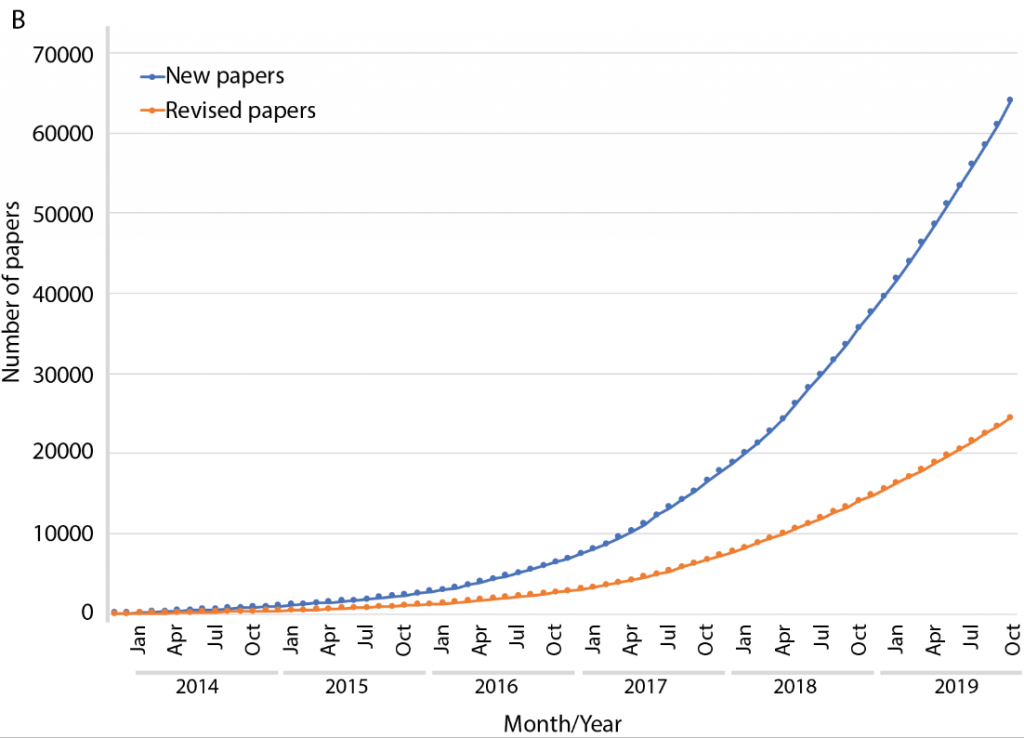bioRxiv: the preprint server for biology
Posted on: 19 November 2019 , updated on: 20 November 2019
Preprint posted on 6 November 2019
More than 64,000 research articles have been shared through the life sciences preprint server bioRxiv as changes in the scientific publication landscape gather pace.
Selected by Jonny Coates, Rob HyndsCategories: scientific communication and education
Background
One of the best known and earliest preprint servers, arXiv, was founded in 1991. Since then, it has revolutionised the publication landscape in the physical and mathematical sciences. Although there had been attempts to replicate this in the life sciences, bioRxiv – introduced in 2013 – has been the first to be widely adopted. This preprint from the team behind bioRxiv updates the scientific community on the uptake and usage of their platform.
Key Findings
1. bioRxiv has grown exponentially since its inception
This preprint tracks the impressive expansion of bioRxiv from its initiation to the present, with close to 3000 new articles per month and articles across the platform attracting more than 4 million abstract views per month (Fig. 1). Interesting trends are noted between disciplines with an initially strong uptake from those with a strong informatics component more recently complemented by rises in contributions from cellular and molecular biology fields. Interestingly, neuroscience contributed the highest proportion of any field since 2017. Encouragingly, the authors reveal that some of the world’s leading research institutions are also those that contribute the most preprints. Furthermore, 70% of preprints are subsequently published as journal articles within 2 years in a variety of venues, with PLOS ONE being the most frequent in 2018 and 2019.
The authors also summarize some of the advantages to posting preprints to bioRxiv. For example, bioRxiv has a rapid submission and screening process, taking 24-48 hours for a preprint to be accepted. There is also the manuscript transfer system that now enables researchers to transfer manuscripts to and from bioRxiv with various journals, negating the need for authors to re-enter the same information across platforms.
In addition to this, the authors highlight features of the platform that are currently underused, such as the ability to summarize revisions that have been made to a preprint upon submission of a revised version and the presence of search functions for email alerts and RSS feeds.
The authors have developed an API to provide up-to-date statistics on bioRxiv usage that are openly available (https://api.biorxiv.org/) which represents an important tool for researchers and organisations that promote the use of preprint servers.

2. bioRxiv user survey
A survey of bioRxiv users found that a majority submit their preprint before (42%) or concurrent with (37%) submission to their preferred journal. Although on-site commenting is low (~5%), preprint authors report high rates of receiving feedback on their work by email, in person or via Twitter. The vast majority of authors (90%) report experiencing no negative consequences of preprinting their work and less than 1% thought that posting a preprint had prevented publication at a particular journal due to their preprint giving ‘the competition’ an advantage – despite this being an often cited reason for not using preprint servers. In terms of motivations for posting preprints, 80% post to increase awareness, 55% to control when their science becomes available, 54% to stake priority and 53% to get feedback on their work. An impressive 54% of respondents report discussing preprints at journal clubs, with a higher percentage amongst early career researchers (60%), showing the forward momentum that preprinting has within the life sciences. In the discussion around this preprint on Twitter it has also been noted that preprints are encouraging authors to present more recent data at meetings.
Conclusions
This preprint illustrates the rapid growth of bioRxiv and increasing adoption of preprints within the life science community. This preprint will reinforce the shift towards preprint publication, provide reassurance for anyone still to be convinced of the benefits of preprints and allow the community to track bioRxiv’s progress in real-time. It also represents a powerful resource for open access and preprint advocates (e.g. ASAPBio) to provide real-time information.
Questions for the authors
Q1. As bioRxiv continues to grow, what roles do the authors envisage for preprint highlighting platforms such as preLights and more generally for the curation of preprints? Does the splintering of the Epidemiology and Clinical Trials subject categories to form medRxiv suggest future specialisation of preprint servers?
Q2. The proportion of manuscripts that are revised stays fairly constant over time and users were enthusiastic about on-site commenting, are there initiatives planned to encourage more feedback-revision cycles using the bioRxiv platform?
Q3. The preprint mentions that additional personalisation of bioRxiv is planned. Could the authors elaborate on this and give us a sneak-peak of what is to come?
Q4. This preprint highlights the acceptance of preprint servers amongst journals, although there were still 6% of survey respondents who stated that posting a preprint limited their choice of journal for publication. Are there any plans to survey journal editors to get their opinions on preprint servers?
doi: https://doi.org/10.1242/prelights.15240
Read preprintSign up to customise the site to your preferences and to receive alerts
Register hereAlso in the scientific communication and education category:
Identifying gaps between scientific and local knowledge in climate change adaptation for northern European agriculture
Anatolii Kozlov
Spurring and Siloing: Identity Navigation in Scientific Writing Among Asian Early-Career Researchers
Jeny Jose
LGBTQ+ realities in the biological sciences
Reinier Prosee et al.











 (No Ratings Yet)
(No Ratings Yet)